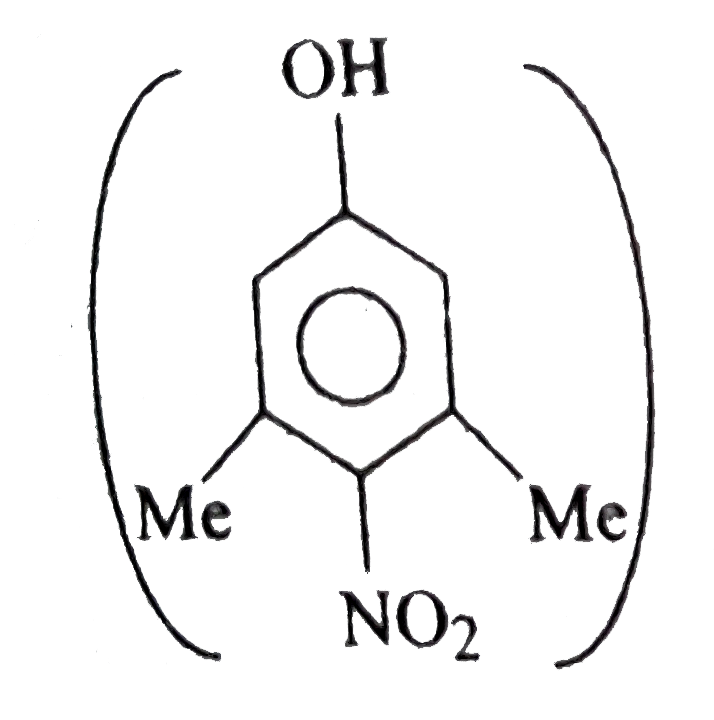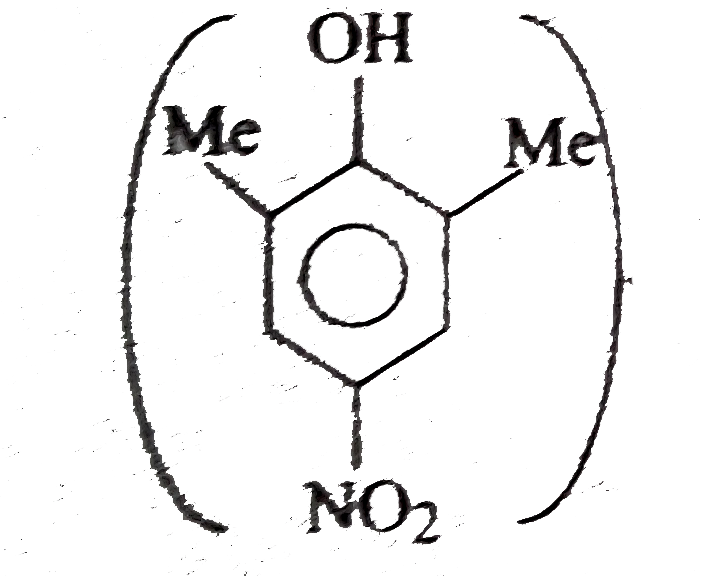Which of the following statemenet (s) is/are correct ?
3,5−Dimethy1-4-nitrophenol (I)  is less acidic than the isomeric 2,6−demthy-4-nitrophenol (II)
is less acidic than the isomeric 2,6−demthy-4-nitrophenol (II)  .
.
(I) is more acidic than (II)
I is less acidic than (II) due to steric inhibition of resonance of two (Me) groups with (NO2) group.
(I) is more acidic than (II) due to less +I effect of two (Me) groups in (I)
The correct Answer is:A, C
To determine which statements about the acidity of the compounds are correct, we will analyze the structure and substituents of the two compounds mentioned: Dimethyl-1,4-nitrophenol and Isomeric-2,6-dimethyl-4-nitrophenol.
1. Identify the Structures:
- The first compound is Dimethyl-1,4-nitrophenol. Here, the nitro group (NO2) is at the para position relative to the hydroxyl group (OH), and there are two methyl groups (CH3) at the 1 and 4 positions.
- The second compound is Isomeric-2,6-dimethyl-4-nitrophenol. In this compound, the nitro group is at the para position relative to the hydroxyl group, but the methyl groups are at the ortho positions (2 and 6).
2. Analyze Acidity:
- The presence of the nitro group, which is an electron-withdrawing group, increases the acidity of the hydroxyl group by stabilizing the negative charge on the phenoxide ion formed upon deprotonation.
- In the first compound, the nitro group can effectively stabilize the negative charge due to resonance.
- In the second compound, the two methyl groups at the ortho position create steric hindrance, which inhibits the resonance interaction between the nitro group and the hydroxyl group. This results in a less stable phenoxide ion.
3. Compare Acidity:
- Due to the steric hindrance in the second compound, the first compound (Dimethyl-1,4-nitrophenol) is less acidic than the second compound (Isomeric-2,6-dimethyl-4-nitrophenol).
- Therefore, we conclude that:
- Option A: Correct (1st compound is less acidic than 2nd)
- Option B: Incorrect (1st compound is not more acidic than 2nd)
- Option C: Correct (1st is less acidic due to steric inhibition of resonance)
- Option D: Incorrect (1st is not more acidic due to the +I effect of methyl groups)
4. Final Conclusion:
- The correct options are A and C.
Summary of Correct Statements:
- Correct Statements: A and C
- Incorrect Statements: B and D
- The first compound is Dimethyl-1,4-nitrophenol. Here, the nitro group (NO2) is at the para position relative to the hydroxyl group (OH), and there are two methyl groups (CH3) at the 1 and 4 positions.
- The second compound is Isomeric-2,6-dimethyl-4-nitrophenol. In this compound, the nitro group is at the para position relative to the hydroxyl group, but the methyl groups are at the ortho positions (2 and 6).
- The presence of the nitro group, which is an electron-withdrawing group, increases the acidity of the hydroxyl group by stabilizing the negative charge on the phenoxide ion formed upon deprotonation.
- In the first compound, the nitro group can effectively stabilize the negative charge due to resonance.
- In the second compound, the two methyl groups at the ortho position create steric hindrance, which inhibits the resonance interaction between the nitro group and the hydroxyl group. This results in a less stable phenoxide ion.
- Due to the steric hindrance in the second compound, the first compound (Dimethyl-1,4-nitrophenol) is less acidic than the second compound (Isomeric-2,6-dimethyl-4-nitrophenol).
- Therefore, we conclude that:
- Option A: Correct (1st compound is less acidic than 2nd)
- Option B: Incorrect (1st compound is not more acidic than 2nd)
- Option C: Correct (1st is less acidic due to steric inhibition of resonance)
- Option D: Incorrect (1st is not more acidic due to the +I effect of methyl groups)
- The correct options are A and C.
- Correct Statements: A and C
- Incorrect Statements: B and D
Topper's Solved these Questions
- GENERAL ORGANIC CHEMISTRYBOOK - CENGAGE CHEMISTRY ENGLISHCHAPTER - GENERAL ORGANIC CHEMISTRYEXERCISE - Single Correct
23 Videos
- GENERAL ORGANIC CHEMISTRYBOOK - CENGAGE CHEMISTRY ENGLISHCHAPTER - GENERAL ORGANIC CHEMISTRYEXERCISE - Assertion-Reasoning
5 Videos
- GENERAL ORGANIC CHEMISTRYBOOK - CENGAGE CHEMISTRY ENGLISHCHAPTER - GENERAL ORGANIC CHEMISTRYEXERCISE - Comprehension
20 Videos
- CLASSIFICATION AND NOMENCLATURE OF ORGANIC COMPOUNDSBOOK - CENGAGE CHEMISTRY ENGLISHCHAPTER - CLASSIFICATION AND NOMENCLATURE OF ORGANIC COMPOUNDSEXERCISE - Analytical and Descriptive Type
3 Videos
- HYDROGEN, WATER AND HYDROGEN PEROXIDEBOOK - CENGAGE CHEMISTRY ENGLISHCHAPTER - HYDROGEN, WATER AND HYDROGEN PEROXIDEEXERCISE - Subjective Archive (Subjective)
3 Videos
Similar Questions
Which of the following statement (s) is /are correct ?
View SolutionWhich of the following statement (s) is/are correct?
View SolutionWhich of the following statement (s) is/are correct ?
View SolutionWhich of the following statement (s) is/are correct ?
View SolutionWhich of the following statement (s) is/are correct
View SolutionWhich of the following statement (s) is/are correct
View SolutionWhich of the following statement (s) is/are correct?
View SolutionWhich of the following statement (s) is/are correct ?
View SolutionWhich of the following statement (s) is/are correct ?
View SolutionWhich of the following statement (s) is /are correct ?
View Solution
